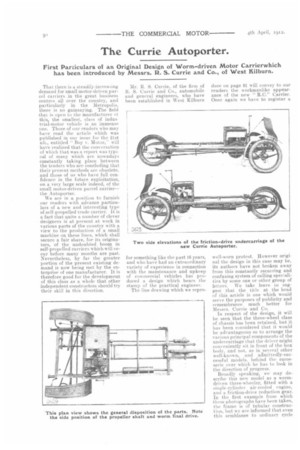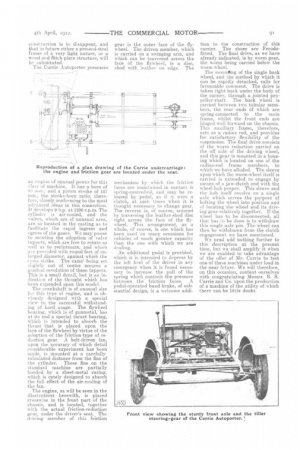The Currie Autoporter.
Page 6

Page 7

If you've noticed an error in this article please click here to report it so we can fix it.
First Particulars of an Original Design of Worm-driven Motor Carrierwhich has been introduced by Messrs. R. S. Currie and Co., of West Kilburn.
That there is a steadily-increasing demand for small motor-driven parcel carriers in the great business centres all over the country, and particularly in the Metropolis, there is no gainsaying. The field that is open to the manufacturer of this, the smallest-, class of industrial-motor vehicle is an immense one. Those of our readers who may have read the article which was published in our issue for the 21st ult., entitled " Boy v. Motor,.' will have realized that the conversation of which that was a report was typical of many which are nowadays constantly taking place between the traders who are concluding that their present methods are obsolete, and those of us who have full confidence in the future exploitation, on a very large scale indeed, of the small motor-driven parcel carrier— the Autoporter.
We are in a position to furnish our readers with advance particulars of a new and interesting type of self-propelled trade carrier. It is a fact that quite a number of clever designers is at present at work in various parts of the country with a view to the production of a small machine on these lines, which shall secure a fair share, for its originators, of the undoubted boom in self-propelled carriers which will occur before many months are past. Nevertheless, by far the greater portion of the present existing demand is now being met by the enterprise of one manufacturer. It is therefore good for the development of this class as a whole that other independent constructors should try their skill in this direction. Mr. H. S. Currie, of the firm of H. S. Currie and Co., automobile and general engineers, who have been established in West Kilburn for something like the past 16 years, and who have had an extraordinary variety of experience in connection with the maintenance and upkeep of commercial vehicles has produced a design which bears the stamp of the practical engineer.
The line drawing which we repro
duce on page 91 will convey to our readers the workmanlike appearance of the new " R.C." Carrier. Once again we have to register a well-worn protest. However origi nal the design in this case may be, its authors have not broken away from this constantly recurring and confusing system of calling specialities by some one or other group of letters. We take leave to suggest that the title at the head of this article is one which would serve the purposes of publicity and remembrance much better for Messrs. Currie and Co.
In respect of the design, it will be seen that the three-wheel class of chassis has been retained, but it has been considered that it would be advantageous so to arrange the various principal components of the undercarriage that the driver might conveniently sit in front of the box body, and not, as in several other well-known, and admittedly-successful models. behind the carosserie over which he has to look in the direction of progress.
Broadly speaking, we may describe this new model as a wormdriven three-wheeler, fitted with a single-cylinder air-cooled engine, and a friction-drive reduction gear. In the first example from which these photographs have been taken, the frame is of tubular construction, but we are informed that even this semblance to ordinary cycle corn:traction is to disappear, and that in future either a pressed-steel frame of a very light nature, or a wood and flitch-plate structure, will be substituted.
The Currie Autoporter possesses
an engine of unusual power for this class of machine. It has a bore of UJ min., and a piston stroke of 127 mm., the stroke-bore ratio, therefore, closely conforming to the most advanced ideas in this connection. it develops 9 h.p. at 1200 r.p.m. The cylinder is air-cooled, and the valves, which are of unusual area, are so located in the casting as to facilitate the rapid ingress and ogress of the gases. We may pause to mention the adoption of valve tappets, which are free to rotate as well as to reciprocate, and which are provided with round feet of enlarged diameter, against which the
its strike. The cams' being set slightly out of centre secures a gradual revolution of these tappets. This is a small detail, but is an indication of the thought which has been expended upon this model.
The crankshaft is of unusual size for this type of engine, and is obviously designed with a special view to the successful withstanding of hard usage. The flywheel bearing, which is of gunmetal, has at its end a special thrust bearing, which is intended to absorb the thrust that is placed upon the face of the flywheel by virtue of the adoption of the friction-type of reduction gear. A belt-driven fan, upon the accuracy of which detail considerable experiment has been made, is mounted at a carefullycalculated distance from the fins of
the cylinder. These fins on the standard machine are partially hooded by a sheet-metal casing, which is cutely designed to absorb the full effect of the air-cooling of the fan.
The engine, as will be seen in the illustrations herewith, is plated crosswise in the front part of the chassis, and is located, together with the actual friction-reduction gear, under the driver's seat., The driving member of this friction gear is the outer face of the flywheel. The driven member, which is carried on a swinging arm, and which can be traversed across the face of the flywheel, is a disc, shod with leather on edge. The mechanism by which the friction faces are maintnined in contact is spring-controlled, and may be released by pedal, as if it were a clutch, at such times when it is thought necessary to change gear. The reverse is, of course, secured by traversing the leather-shod disc right across the face of the flywheel. This arrangement, as a whole, of course, is one which has been used on many occasions for vehicles of much greater capacity than the one with which we are dealing.
An additional pedal is provided, which it is intended to depress by the left heel of the driver in any emergency when it is found necessary to increase the pull of the spring which controls the pressure between the friction faces. A pedal-operated band brake, of substantial design, is a welcome addi tion to the construction or this carrier. The shoes are Ferodofitted. The final drive, as we have already indicated, is by worm gear, the worm being carried below the worm-wheel.
The mounng of the single back wheel, and the method by which it can be rapidly detached, calls for favourable comment. The drive is taken right back under the body of the carrier, through a jointed propeller-shaft. The back wheel is carried between two tubular members, the rear ends of which are spring-connected to the main frame, whilst the front ends are hinged well forward on the chassis. This auxiliary frame, therefore, acts as a radius rod, and provides for satisfactory flexibility of the suspension. The final drive consists of the worm reduction carried on the off side of the driving wheel, and this gear is mounted in a housing which is located on one of the radius-rod frame members, to which we have alluded. The sleeve upon which the worm-wheel itself is carried is extended to engage by means of a jaw-clutch end with the wheel-hub proper. This sleeve and the hub itself revolve on a single axle which serves the purpose of bolting the wheel into position and of locating the wheel and its driving gear relatively together. If the wheel has to be disconnected, all that has to be done is to withdraw this single axle pin. The wheel can then be withdrawn from the clutch engagement we have mentioned.
We need add nothing further to this description at the present time, but we shall amplify it when we are enabled to take advantage of the offer of Mr. Currie to test one of these machines under load in the near future. We will therefore, on this occasion, content ourselves with congratulating Messrs. R. S. Currie and Co. upon the production of a machine of the utility of which there can be little doubt.






















